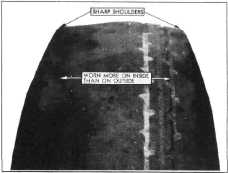1942 - 1947 CHEVROLET SHOP MANUAL
Section 10 - Wheels & Tires
|
|
|||
|
10-3
|
|||
|
|
|||
|
CORNERING WEAR
The modern independently sprung front wheels
on automobiles allow the drivers
to make turns at a
considerably higher rate of speed with the
same feeling of security as they
had with older
|
the
outside shoulder or edge of the tire and by the roughening of the
tread surface in this region denoting severe abrasion, Figs. 6 and 7.
In addition, cornering wear often produces a
fin or raised portion along the
inside edge of each row in
the tread pattern. In some cases this fin is
almost as pronounced as a toe-in
fin and in other cases it
tapers into the row of tread blocks to such an extent that the tire
has a definite step wear
appearance, Fig. 7. That is, the outside
edge of any tread row is worn more
than the inside edge which
gives an appearance of steps when looking directly at the tire.
Cornering wear of this nature is
usually found in sections of the
country where a great deal of
turning is necessary on open highways.
Cornering wear in
severe cases can be found on rear
tires as well as on front tires. On rear tires
the step condition is usually the
most apparent and is almost always accompanied by a rounding of
the outside shoulder of the tire.
Pure camber wear on the rear from overloaded axles will leave a
definite sharp edge on both
shoulders of the tire, and the inside rows of the tread will be
worn more than the outside rows without any semblance of a step wear
condition, Fig. 8.
|
||
 |
|||
|
Fig. 4- "Cornering Wear" Due to Scrubbing on
Fast Turns
cars at lower speeds.
This fact is responsible for a comparatively new type of tread wear
very often confused with excess
camber wear which is caused by excess positive camber or high
crowned roads.
We will call this new type of wear "cornering
wear" as it is a result of the
scrubbing produced by driving fast on curves, turns, and
corners.
|
|||
 |
|||
 |
|||
|
Fig. 8-Rear Tire Wear Due to Improper Camber
On front tires camber
alone would wear the outside rows more than the inside rows without
any semblance of step wear, and
would leave the shoulders sharp on both sides. However, this is
very rarely found without some
cornering wear. This camber of the wheels should be corrected
only when it is beyond the
factory specifications and
when the abnormal camber characteristics of the tread wear outweigh
the cornering characteristics,
When cornering wear is
encountered the owner should be
shown, by the rough tire surface, that he
is severely damaging his tires by
fast or sharp turns, and
told that he could greatly prolong the
|
|||
|
Fig. 7-"Step Wear" Due to Frequent Turning
Cornering wear can be most easily distinguished
from abnormal camber wear by the
rounding of
|
|||
|
|
|||